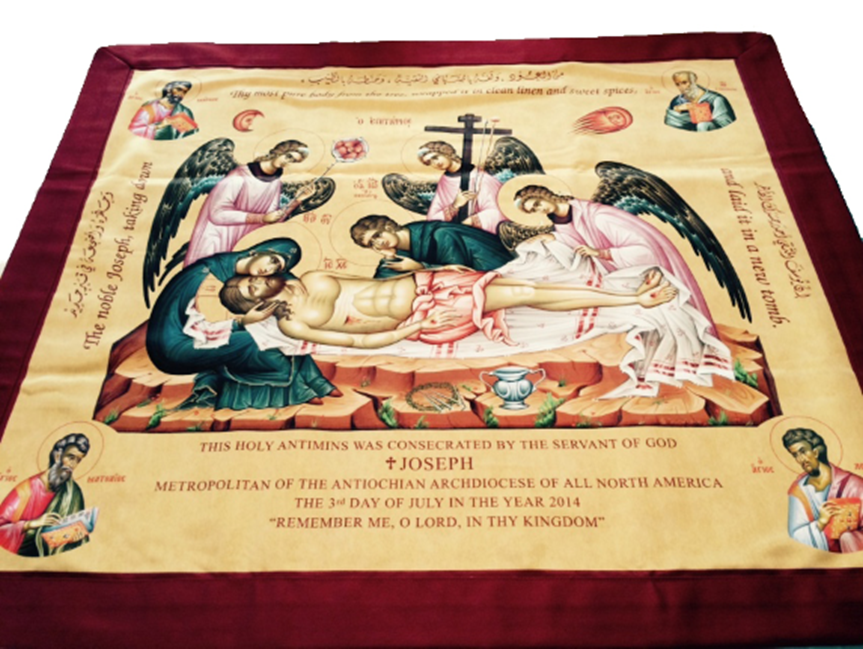ANTIMENSION

The antimension (from GR: "in place of the table"; in SL: ANTIMINS) - is among the most important liturgical adornments used in the Altar during the Divine Liturgy. This rectangular piece of fabric (usually linen or silk) is typically decorated with representations of the entombment of Christ, the four Evangelists, as well as scriptural passages related to the Eucharist. A small incorruptible relic of a martyr is sewn into it making real the early liturgical connection with the Martyrs who died rather than renounce Christ, and whose blood, after the Blood of Christ, formed the very foundation of the Church. The Eucharist cannot be celebrated without an antimension which is consecrated and signed by the ruling Bishop of the Diocese. It is usually wrapped in another protective cloth called the Iliton, which is often red in colour and symbolizes the swaddling-clothes with which Christ was wrapped after His birth, and also the winding-sheet in which His body was wrapped after His Crucifixion. The ANTIMENSION is placed in the center of the Holy Table and is unfolded only during the Divine Liturgy, before the Anaphora; the Eucharist is consecrated on it. At the end of the Liturgy, it is folded in thirds, and then in thirds again, so that when it is unfolded the creases form a cross. A flattened natural sponge is also kept inside the ANTIMENSION, which is used to collect any particles which might fall onto the Holy Table. When the ANTIMENSION and Iliton are folded, the Gospel Book is laid on top of them. Only a bishop, priest, or deacon is allowed to touch an antimension. Since the antimension is a consecrated object, they must be vested when they do so—the deacon should be fully vested, and the priest vested in at least stole and cuffs.
ANTIMENSION
L’ANTIMENSION (du GR « à la place de », « au lieu de », et latin mensa — « table ») signifie littéralement « à la place de la table (de l’autel) ». Concrètement, l’ANTIMENSION est un tissu rectangulaire (en lin ou en soie), décoré de représentations de la mise au tombeau du Christ, des quatre évangélistes, ainsi que de passages scripturaires liés à l’Eucharistie. Un petit sachet contenant une petite relique incorruptible y est cousu, rendant ainsi réel le lien liturgique avec les martyrs qui sont morts plutôt que de renoncer au Christ, et dont le sang, après le sang du Christ, a formé le fondement même de l’Église. L’Eucharistie ne peut être célébrée sans un ANTIMENSION consacré et signé par l’évêque diocésain. Il est généralement enveloppé dans un autre tissu protecteur appelé iliton, qui est souvent de couleur rouge et qui symbolise les langes dont le Christ a été enveloppé après Sa naissance, ainsi que le drap dans lequel Son corps a été enseveli après Sa crucifixion. L’ANTIMENSION est placé au centre de la Sainte Table et n’est déplié que pendant la Divine Liturgie, avant l’Anaphore, et c'est sur l'ANTIMENSION qu'on apporte les saints dons. À la fin de la liturgie, il est plié en tiers, puis à nouveau en tiers, de sorte que lorsqu’il est déplié, les plis forment une croix. Une éponge naturelle aplatie est également conservée à l’intérieur de l’ANTIMENSION; elle est utilisée pour recueillir les particules qui pourraient tomber sur la Sainte Table. À la fin du service, après la communion, le prêtre replie l’ANTIMENSION, le remet à sa place et pose l’Évangile dessus. Seuls un évêque, un prêtre ou un diacre sont autorisés à toucher un ANTIMENSION. Puisque c’est un objet consacré, ils doivent porter leurs vêtements liturgiques et le prêtre revêtu au moins de l’étole et des surmanches.
الأنديمنسي
الأنديمنسي (من اليونانية : "بدل المائدة" وبالسلافية "أنتيمينس") من بين أهم أدوات العبادة المزخرفة المستخدمة في الهيكل خلال القداس الإلهي. وهي قطعة من القماش مستطيلة الشكل (عادة من الكتان أو الحرير) مزينة بشكل نموذجي بتمثيل مشهد دفن السيد المسيح، والإنجيليين الأربع، إضافة إلى مقاطع كتابية تتعلَّق بالإفخارستيا (المناولة المقدسة أو سر الشكر). هذا ويتم خياطة قطعة صغيرة فيه من بقايا شهيد غير قابلة للفساد، مما يجعله مرتبطاً بحق بالحياة الليتورجية المبكرة للشهداء الذين آثروا الموت على إنكار السيد المسيح، والذين شكَّلَ دمهم، بعد دم المسيح، أساس الكنيسة الحقيقي. لا يمكن إقامة خدمة الإفخارستيا من دون وجود الأنديمنسي الذي يُكَرّسه ويوقعه أسقف الأبرشية المسؤول. وهو عادة ما يكون ملفوفاً بقطعة قماش أخرى للوقاية تدعى "إيليتون" وغالباً ما تكون حمراء اللون، وترمز إلى أقماط السيد المسيح التي لُفَّ بها بعد ولادته، وكذلك إلى الغطاء الذي لُفَّ به جسده الطاهر بعد صلبه. يوضع الأنديمنسي في وسط المائدة المقدسة، وتُفتَح طياته فقط خلال القداس الإلهي قبل الأندفونا ويُكرَّس القربان المقدس عليه. في نهاية القداس الإلهي يتم طيه إلى الثلثين، ومن ثم إلى الثلثين مرة أخرى، بحيث تَرسِمُ الطيّات شكل الصليب عندما يُمَدُّ الأنديمنسي. يحتفظ بداخل الأنديمنسي بقطعة مسطحة من الإسفنج الطبيعي والتي يتم استخدامها لجمع الفتات التي قد تسقط على المائدة المقدسة. هذا ويوضع الإنجيل فوق الأنديمنسي والإيليتون بعد طيّهما. لا يُسمح لأحد بلمس الأنديمنسي باستثناء الأسقف والكاهن والشماس وبما أن الأنديمنسي مُكرس فعليهم ارتداء لباسهم الكهنوتي أثناء تداوله حيث يجب أن يكون الشماس مرتدياً لباسه كاملاً والكاهن مرتدياً البطرشيل والأكمام على الأقل.